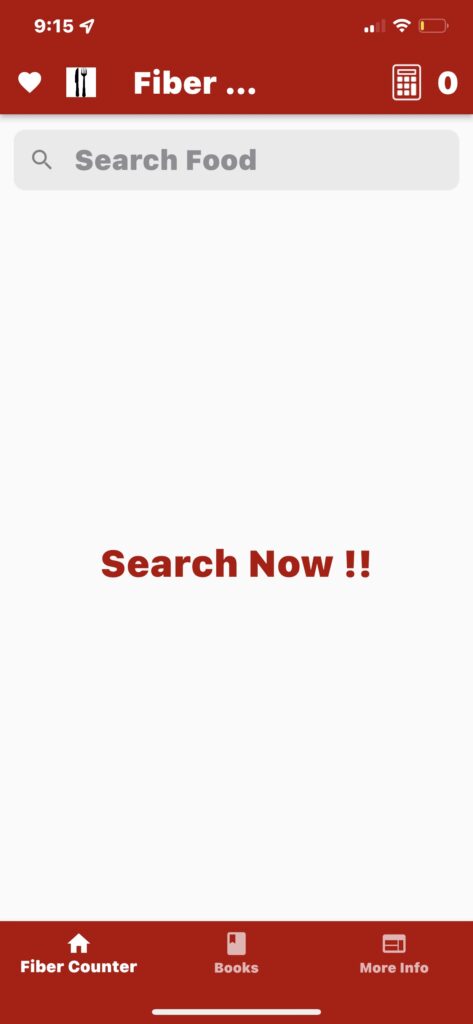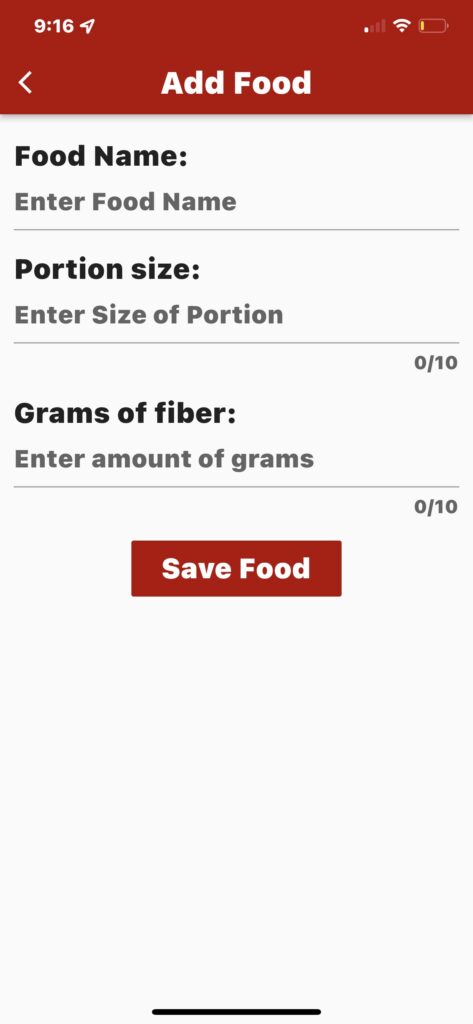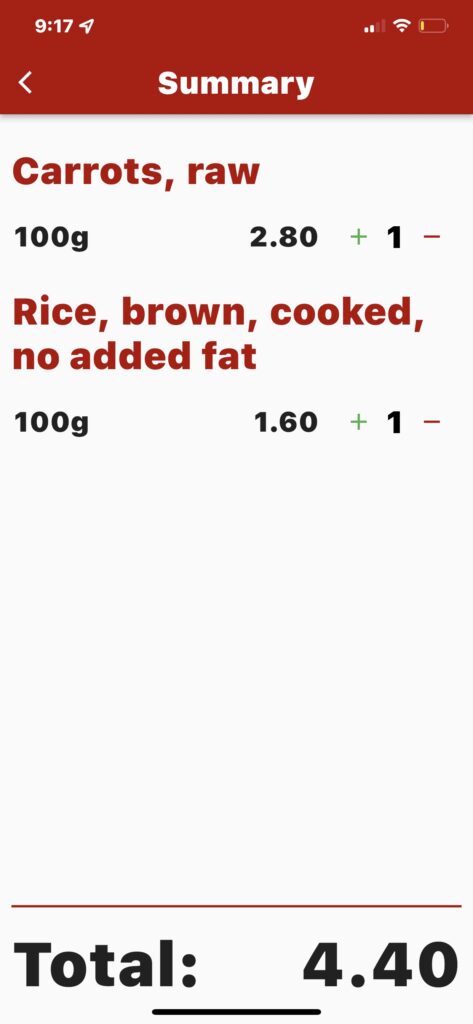Fiber Counter Ap – Let’s Get Things Moving
Fiber Counter Ap is a SIMPLE FREE App that allows you to do a quick tally of your total daily dietary fiber intake in grams to help keep you on track.
- Features and Benefits
- How does it work?
- Download the App from the Apple App Store or Google Play Store. New Updated Version Soon!
- FAQ
- Dietary Fiber Information
Features and Benefits
- Search the United States Food Database: The app provides access to a comprehensive database of food items in the United States, which makes it easy for users to search for and find the amount of dietary fiber for specific foods.
- Ability to add own foods for future use: The app allows users to add their own custom food items, which is particularly useful if the food item they are looking for is not in the existing database.
- Add or subtract items: Users can easily add or subtract food items to their daily intake, which can help them keep track of their overall dietary fiber intake.
- Tally total fiber intake: The app allows users to track their daily fiber intake, which is important for maintaining good digestive health and can help prevent chronic diseases like heart disease, diabetes, and certain cancers.
- Add a food to your favorites: Users can save food items they frequently eat to their favorites, making it easy for them to add those items to their daily intake without having to search for them each time.
- Add your own food item to the calculator: The app allows users to add their own food items, including the name of the food, the amount, and the grams of fiber it contains. This can be particularly useful for users who have unique dietary needs or preferences.
Overall, the Let’s Get Things Moving Fiber Counter App provides a range of useful features that can help users track their dietary fiber intake, which can help them make healthier choices and achieve the recommended daily intake of fiber. 25 grams for women and 30-35 grams of dietary fiber for men.
How does it work? How to use this App:
Use the search functionality to look up a food item and add it to your daily fiber tally. Type the food item you are searching for. Please note the food items shown are based on the United States food database. US food terminology is different to the UK or Australia. For example, a bell pepper is referred to as capsicum in Australia, or pepper in the UK. To find this item you will need to search for the US name “bell pepper”.
If you are searching for a carrot you will see Carrots, Raw come up the list.
Click the item and then select the amount. To add it to your total, click the plus symbol.
Add your own food item
If you are searching for a branded food name (or other food item) and can’t find it, you can add your own food item to your list by clicking the knife and fork button.
This may be helpful as you will not find branded foods outside of the United States. For example, a popular sweet biscuit in Australia is Tim Tams. If you search for this food item in the app you will not find it because this product is not sold in the United States. To get the fiber amount of a food item that is not listed check the packet/label for the fiber amount. Alternatively do a quick google search to find the amount of fiber in your food item. Add the details and click save.
Favourites
If you have a food item that you eat everyday, you can add it to your own favourites list by clicking the heart button
Click the heart button to access the favourites list, use the heart button to add a food item to you favourites list.
View a Summary of your Fiber Count
To view, a summary of your fiber count click the calculator and the summary will be displayed. You can add or remove items by using the + or – symbol.
Free downloadable health books
Click the Books button at the bottom of the app to access the list of free books available for download.
More Info
This is the page that explains how to use the Fiber Counter App.
FAQs
- What is the name of the app and where can I download it?
Let’s Get Things Moving Fiber Counter App, by Katie Larking. The App is available for download from Apple App Store and Google Play Store.
- What is the source of the food database used in the app?
The United States Department of Agriculture (USDA) National Nutrient Database for Standard Reference
- Can I track other nutrients besides fiber, such as protein and carbohydrates?
No, only dietary fiber. The app is designed to be simple to use and focused on tracking and reaching your dietary fiber intake.
- Is the app available in languages other than English?
No, the app is only available in English.
- How accurate is the nutritional information in the app?
The United States Department of Agriculture (USDA) National Nutrient Database for Standard Reference is considered to be a reliable and accurate source of nutritional information for most foods. The database is updated regularly to reflect changes in food production, processing, and preparation methods, and the nutrient data is analyzed and verified by USDA scientists to ensure accuracy.
That being said, it’s important to keep in mind that the nutritional content of foods can vary based on a variety of factors, including growing conditions, processing methods, and cooking techniques. Additionally, the nutrient content of fresh, whole foods can be affected by factors such as ripeness and seasonality.
Overall, the USDA food database is a reliable and trustworthy source of nutritional information for most foods. However, it’s always a good idea to double-check the nutritional information on packaged foods and to consult with a healthcare professional or registered dietitian if you have specific dietary concerns or needs.
- Can I track my daily calorie intake using this app?
No, only dietary fiber, the app is designed to be simple to use with a focus on reaching your dietary fiber intake goals.
- Is there a way to set a daily fiber goal in the app?
No, this feature is currently not available, however, will be considered for the next round of enhancements.
- Can I create and save my own meal plans using the app?
No, however, you can save your own foods in the app, see the instructions above.
- Does the app sync with fitness trackers or other health apps?
No.
- Can I use the app to track my water intake as well as dietary fiber?
No, this feature is currently not available, however, will be considered for the next round of enhancements.
- How do I add a custom food item to the app?
- Is there a community or support system within the app?
Yes, please visit the BetterHealth4You Facebook Page if you have any questions or need support.
- Can I use the app offline, without an internet connection?
No, an internet connection is required for the app to work.
- Does the app offer any personalized recommendations or tips based on my dietary goals?
No.
- Is there a premium version of the app with additional features or benefits?
No.
Dietary Fiber Information
Dietary fiber and health
Dietary fiber is the food that feeds the gut microbiome, as such dietary fiber and health and codependent and play a crucial role in our health.
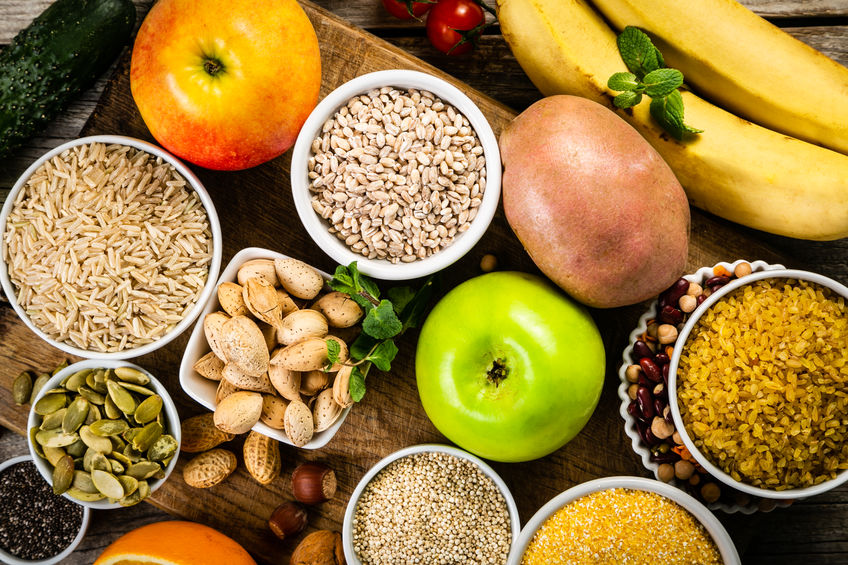
Types of dietary fiber
Dietary fiber comes in two forms water soluble and insoluble to water.
Plant based fiber are called cellulose, hemicellulose, or lignin.
Other compounds called insoluble fiber include chitin and resistant starch. However, there are more not listed here.
A summary of Soluble vs Insoluble Fiber (1)
Soluble Fiber
- Prolongs stomach emptying so sugar is absorbed slower
- Binds with fatty acids
- Lower total cholesterol and LDL
- Regulates blood sugar for people with diabetes
- Reduces risk of heart disease
Insoluble Fiber
- Maintains optimal balance of good microbes
- May help prevent cancer
- Promotes regular bowel movement
- Prevents constipation
- Removes toxins quickly
Insoluble fiber are carbohydrates that are the edible portion of plants that resists digestion and absorption in the small and large digestion.
Dietary Fiber and Health – Other benefits
There are many more benefits of digestion including:
- Promoting a sense of fullness
- Regulation of digestion
- Is low in calories and great for weight loss
Fiber is critical to health
After you do a bit of research you find that dietary fiber should be an essential nutrient and perhaps one could argue that it is as critical to good health as vitamin C. Dietary fiber and health go hand in hand.
Fiber even acts as a stimulant for the liver and digestive processes. This increases the production of bile and research shows that it may help prevent gallbladder stones.
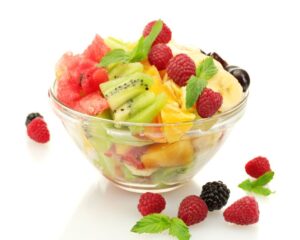
What happens when fiber ferments?
The beneficial microorganisms in the gut are called symbiotes. This is created when fermentable fiber is fermented, creating short-chain fatty acids (SCFA). This promotes health including:
lower colonic pH (i.e., raises the acidity level in the colon) which protects the lining from formation of colonic polyps and increases absorption of dietary minerals that stimulate production of T helper cells, antibodies leukocytes cytokines, and lymph mechanisms. Crucial roles in immune protection, improve barrier properties of the colonic mucosal layer.
Inhibiting inflammatory and adhesion irritants contributing to immune functions. (2)
The more you eat the more fiber you need.
The more calories you EAT THE MORE FIBER YOU NEED.
The British Nutrition Foundation recommend a minimum is 18 grams a day for health.
American dietary association 20-35 grams depending on calories consumed. Men are recommended to have more as they generally eat more than women.
However, average fiber intakes for US children and adults are less than half of the recommended levels.
Dietary fiber intake provides many health benefits.
“Individuals with high intakes of dietary fiber appear to be at a significantly lower risk for developing coronary heart disease, stroke, hypertension, diabetes, obesity, and certain gastrointestinal diseases. Increasing fiber intake lowers blood pressure and serum cholesterol levels.
Increased intake of soluble fiber improves glycemia and insulin sensitivity in non-diabetic and diabetic individuals. Fiber supplementation in obese individuals significantly enhances weight loss. Increased fiber intake benefits a number of gastrointestinal disorders including the following:
- gastroesophageal reflux disease
- duodenal ulcer
- Diverticulitis
- Constipation, and hemorrhoids.
Prebiotic fibers appear to enhance immune function.” (3)
Fiber intake can improve longevity

The National Institute of Health found that dietary fiber intake was significantly inversely associated with the risk of total death in both men and women. In other words in increases healthspan.
It is important to remember that dietary fiber helps to negate the negative effects of sugar. Typically you will not find high sugar processed foods containing much fiber. An increase in fiber can cause an increase ing gas. Some types of fiber can block vitamin absorption.
Increase your fiber intake slowly.
Eating too much fiber or going from a low fiber diet to high fiber diet quickly can cause significant digestive upset so it is important to gradually increase your fiber intake.
Water is critical with increased fiber intake.
When increasing fiber it is very important to increase water intake.
One needs to be careful with certain types of fibers as they absorb lots of water. Chia seeds absorb 27 times their weight in water.
Dietary fiber feeds the good bacteria in the microbiome. The microbiome has large impact on the immune system and hormone production system.
A number one cause of symbiotic death (death of good bacteria) is lack of dietary fiber in our diets, antibiotics and glyphosate (round up).
So what can we do to protect ourselves and preserve our good bacteria?
A natural pre and probiotics can help to replenish the balance of good bacteria after taking antibiotics. It is also good to support general maintenance.
In conclusion, it is important to get a healthy amount of dietary fiber:
And most importantly increasing the amount of dietary fiber in the diet to the recommended amounts of 25-35 grams a day. Include lots of plant based foods, vegetables, fruits, nuts, legumes, and whole grains.
References
(1) https://www.uccs.edu/Documents/healthcircle/pnc/health-topics/Soluble_Insoluble_Fiber.pdf
(2) https://en.wikipedia.org/wiki/Dietary_fiber
(3) Nutrition Reviews® Vol. 67(4):188–205
Would you like to learn how to improve your fiber intake in your diet? Please contact me.
For more information please contact Katie +61 422 538 801 (Melbourne) or email [email protected]

